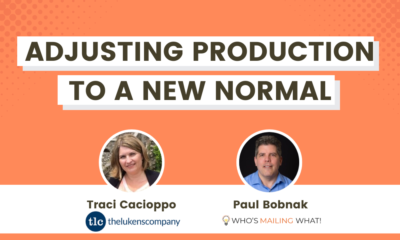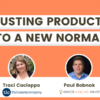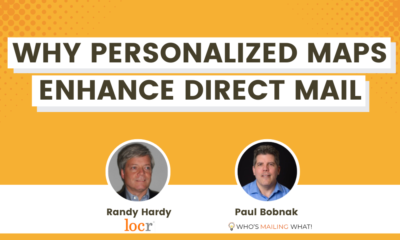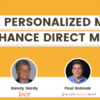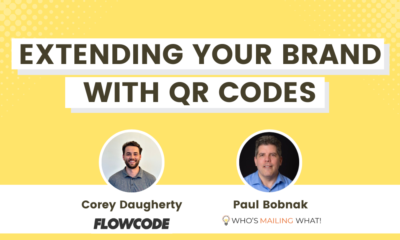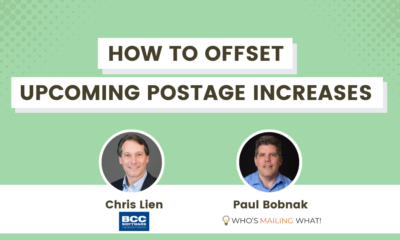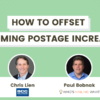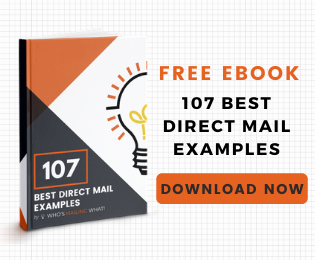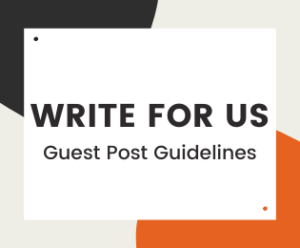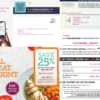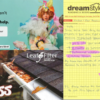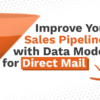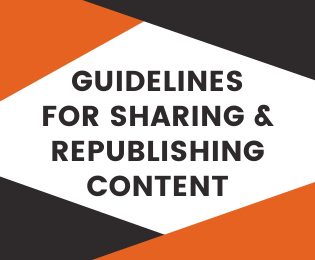MEET THE MAILERS
Meet the Mailers: Building Long-Term Customer Relationships
In this episode, we talked with two executives from NextPage about how the company works with clients from “the idea to the mailbox” and “do something better” with data and creative, among other things.
In this episode, I talked with two executives from NextPage, CEO Gina Danner, and Sam Sewell, Senior Account Executive.
Headquartered in (and technically, under) Kansas City, MO, NextPage is a total marketing solutions provider combining traditional print expertise with personalized digital marketing techniques. We talked about how the company works with clients from “the idea to the mailbox” and “do something better” with data and creative, among other things.
As Gina explained:
Direct mail is not something to trifle with …. It’s a consistent effort over and over and over again.
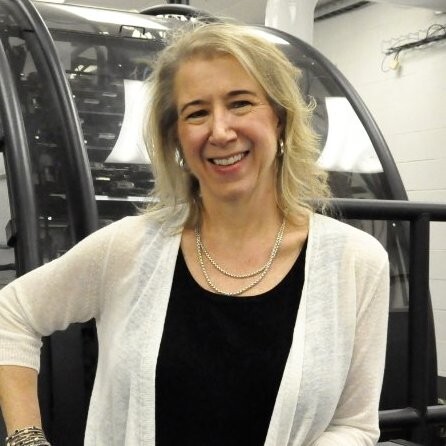 Gina DannerCEO
Gina DannerCEO
NextPage
Among the many topics we covered:
- The backgrounds of both Gina and Sam
- Big Data in mail – its challenges & opportunities
- Improving mail ROI
- Working with clients on campaign planning
- Trends in direct mail
Here are some questions and answers (edited for clarity and space):
- For the best chance of successfully reaching customers, campaigns should be a combination of channels, including mail of course, so what kind of foundation is needed before getting started?
Gina: So one of the big challenges we see in the marketplace is this concept of Big Data.
[T]hat just means there’s a whole lot of it. And so many clients don’t understand what data they have, how they can use the data and how they can dig into their customer or prospect base to really target the right people with the right message on – what we like to say – on the right page.
So that’s one of the things we really try to focus on is starting with the data and then going all the way through the process. For years and years and years, I’ve said, NextPage is the only printer that will tell you to mail less. And so as budgets get strapped, as people see value in other channels, we have to make sure that the mail is very valuable and generates the results that are necessary.
So whether that is data modeling to find consumers that have a high propensity to convert with direct mail, whether that’s taking out a sector of the database and focusing on digital marketing, it’s really about digging deeper into the data. And then everything else becomes gravy on top of that. If the data gets messed up at some point in time, whether they’re on the client side, on the vendor side, or is targeting the wrong people, it’s just ripe for waste.
And so we try to really make sure that we put the odds in our favor of being successful by making sure our clients understand the value and the depth and the focus of their data.
Sam: And we’ll, we always start with data. To Gina’s point, and to her credit, she did tell, the first prospect that I brought to NextPage in the first meeting was, “maybe you do need to mail less.”
I thought, well, I thought that’s what we did. Well, the reality is we want to be successful for our clients. We want a long-term relationship. So sometimes not everyone has the propensity to respond to direct mail. So therefore you look at it a different way.
But, you know, I’ve had someone give me 11 postcards from one of the largest direct consumer brands in the country. And it was because they joined a loyalty membership. They got 11 postcards. So it’s not just, you know, the data out, it’s about making sure we’re targeting the right people, but also clean the data and we will continually talk about that because it is the most important aspect of any successful campaign.
Sometimes it’s about saving money, and maximizing the budget. It’s always about actually maximizing the budget, making sure we’re targeting the right audience.
Like non-profits is an example.
A lot of them have legacy systems and they continue to retarget the same people over time. Sometimes we’re never revisiting whether or not they’re actually successful campaigns or who’s responding. It’s just [you need to] slow down sometimes.
So the more we understand of someone’s world and the more they’ll let us open the door and start to unpack things, cuz we do need to understand it if we’re really going to bring real value to them, long-term to keep a valuable relationship and for success for both, for them to improve whether it’s response rates or increased donations or, you know, better conversions.
And on our end, we wanna be successful and help both of us make money.
- How have postage and paper increases affected design and mail pieces and even strategy?
Gina: So what we try to focus on is the postage is typically the biggest cost, where clients will go back and forth about “do I want a six by nine postcard, or a nine by 12, you know, or a six by 11 postcard, or a nine by six” …whatever they want. All with the thought of saving a little bit of money on the cost of the paper.
Well, the postage is the most expensive component of a direct mail piece. So the key is we have to maximize the message when we actually get the opportunity to. So we look at higher value mail pieces, whether it’s with messaging because we have good data from a client so we can create a relevant message and more relevant graphics to the actual person receiving them.
We may use a shape cut envelope or a shape cut postcard. We may add some foil or embellishments to maximize the image on the piece. There’s just a variety of ways we can go in once we understand what the end goals are and how we wanna attack it. Of course, paper’s been a big hot topic for the last 18 months or so, but it’s just one of many topics that have to be addressed.
But no matter what happens with paper cost, postage is going to be the biggest item. So making sure that we’re targeting the right individuals with the right message, and then maximizing the pennies that we’re spending on the print so that we’re getting the best bang for the buck.
You know, at NextPage, a shape cut envelope really doesn’t cost any more than a regular envelope. You know, if somebody’s doing 50,000 of ’em and we’re doing a high-designed envelope, let’s go ahead and make it a shape cut envelope.
Sam: And it’s been interesting too. Paper’s an issue. It’s good to continue to be, we don’t know how far out before the supply chain calms down, and I don’t know if we’ll ever get back to what we all remember as normal. So out of that has come with some additional opportunities for our clients for planning, whereas before, you know, the third and fourth quarter, everyone’s hair is usually on fire because they have forgot something. Traditionally, they’ve been able to get a direct mail campaign with creative and everything to a vendor and processed in a certain period of time.
Well, the traditional schedules have changed, but the benefit is we’ve been able to … I mean, a lot of our clients really do plan ahead, obviously. But there’s still some that traditionally hadn’t made it that necessarily a priority, and it’s allowed us to have some deeper conversations with them. And personally in my book of business, it’s strange, but in a weird way …I don’t say it’s beneficial, but it hasn’t been as crazy. this fourth [quarter] simply because we’re so far ahead of it in planning and it’s almost changed their mindset. Now we’re looking ahead … we’re actually all the way out in the third and fourth quarter of 2023 already.
But we’ve also been able to consider some other opportunities going back to the postage increases. We have one client that schedules were always an issue. We would never be able to consider or take advantage of commingle if it made sense, and in their case it does. And we were able to hold postage costs utilizing commingle.
In their world, it’s five to six grand per mailing that we were able to put back into their pocket with the additional planning and those additional conversations. So it’s there and we’re all going to be dealing with it continually. Postage is gonna keep going up, but NextPage is a company that truly does try to think outside the box on an ongoing basis.
An example of that is we have a postcard that we do for clients, laminated postcard, and without changing any production costs, added a die cut shape on the trail edge, and it’s the same. We have to die cut the cards anyway … same production process, but just looking for some alternative ways to add value to the piece.
The team here’s always looking for something like that. So it’s not just maximizing postage, it’s… somebody noticed something, bringing up on an offer or whatever … It’s nice to be able to take that much value to market on a continuing basis.
- Well, along the same lines more generally speaking, how can marketers improve their direct mail ROI?
Sam: [to Gina] You’re gonna say mail less! No. Not always right?
Gina: Well, I don’t wanna beat a dead horse. It’s, again, it’s narrowing the focus on their data. And it’s the biggest thing I think we learned years ago is, I don’t want somebody to quote “try direct mail”. It is an expensive proposition to quote “do brand building” with direct mail.
The key is, is to use direct mail to close the action and then move the customer forward, whatever that is. Use online advertising, use radio advertising, use some kind of mass communication to brand build, and then deliver the killer message, the killer offer with direct mail. So warm the prospect up – as long as it’s the right prospect – and then come in with direct mail. Again, cutting the prospect pool down and, and you’re gonna more likely be successful …
We used to get a lot of people who’d say, “well, I’d like to give direct mail a try”. And back in my younger days I’d be like, “OK, great, we’ll go create a great direct mail campaign and create a great thing!”
And they’ll be like, “oh, well that, you know, I tried direct mail once and it didn’t work.” Well, direct mail is not something to trifle with. Now I tried working out once and my backside isn’t skinnier. It’s a consistent effort over and over and over again.
Sam: It is a little scary when someone does call and they just wanna launch a campaign.
And they’re gonna measure the results of a single campaign, but they’re not measuring the results across all of their channels, and then what direct mail added its value, and to whom it was successful.
In a marketing automation journey or where you have these online touches, direct mail is a powerful tool as an offline touch, and it can be as variable as a digital communication.
If your asset library is managed correctly, or if the assets can be changed – and they can for direct mail – then if the images are there, you can pull them in through automation and send someone a photo of the refrigerator that they almost purchased less than 48 hours ago.
So getting that message … to Gina’s “the right message, on the right page, right time” … powerful tool, but, and I’m joking about mail less. We wanna mail more, we want the right mail and we want our clients to be successful. We don’t want someone to just try it one time and not consider all of the other brand impressions.
They do build up to the success of that campaign. You know, we do some digital marketing in correlation with the direct mail and brands that have obviously better brand awareness, both are better, when [there’s] a powerful tool combining them.
- When do you suggest that prospects or clients bring you to the table? In other words, when are you most successful being brought in to talk about putting direct mail to use in a campaign like maybe budgeting or before plans are even put forward.
Gina: We find that the more transparent our clients are with us, the more successful they will be, whether it’s timing and resource management and planning.
You know, we have, I don’t know, $15, 16 million worth of equipment here. The goal is to keep that equipment busy. If clients will stop when they’re doing their annual planning and say, “let’s bring NextPage to the table now”. We can then help them understand when we can maybe save time or save money along the process when we can help them do something better.
Over the years we’ve seen clients that have really big aspirations for a really significant campaign, and they need it to be significant and they need significant results, but they don’t give it enough time to get through good creative, to get through good process, to make sure that it has enough life.
There are times when as we look at the year, it may make sense instead of, you know, if a client wants to mail 12 times a year, it may make sense in their business cycle where they’re thinking, “maybe we mail monthly”. They may need to mail 10 of those touches before June. You know, there’s just a variety of things that come into it.
So we can real quickly sit down at the table, help them get a straw budget put together, to get a straw pulled or kind of a straw plan together so that then they can start narrowing and focusing and we can get some ballpark estimates. We can figure out where’s the best paper to source, how are we gonna go about production methodologies, you know, what is the whole thing going to come together, figure out if they’ve got the right data, if they can get it pulled out from their system, is there enough in, is there data augmented to a level that we can actually do something with it?
I’ve been in meetings where the clients strategized on very complex creative campaigns because they know all the data’s in their system. But then when it came to actually extracting the data, it wasn’t translated the right way and nobody knew that. So it’s like what happened is they planned on mailing 120,000 pieces …, and a very complex, very cool, impactful type. The testing was phenomenal. They were gonna make zillions of dollars with it.
When it actually came down to pulling enough data out, they only had about 12,000 records that have the data science. And it was just, it was a fluke thing that the way the products are defined in their system didn’t come through the way that they had originally been planned to come through.
Stuff happens. So it’s really, it’s like we usually, like I’m working with a client now and the first thing we’re gonna do is go through and analyze, they’re dealing with nine different data sets within their organization. And so how are we gonna pull and deal with, and try to extract enough data to make it a beneficial campaign for them.
Sam: I would answer that, Paul, is wherever they are now.
Because if we all are gonna have to do a better job of planning, even if you’re already got your budget for 2023, we might need to be talking about 2024. Rebuying paper, we like to be involved at the ground level of the results of your campaigns.
We want to talk through everything from beginning to end, what you know, what can we learn and to help add more value. You’ll ask us, you know, you keep asking about direct mail and our first response is always “data” and whatever question you ask us, it’s “data”. It’s where we wanna be involved, but it’s because it’s the most powerful.
Do we do really cool stuff? Yeah!!
I mean, the equipment we have, we can produce, we can tip on almost anything. We have all the cool shapes, self-mailers, the folds, the popups. We did a circle folded down to a four by oh, four by nine self manner. We can do all of that stuff. So can we add the value after the data and manage it? Yes.
It’s really on that front end. Um, and NextPage develops solutions specific to clients and what they need. I mean, some of our clients manage print services. Um, we’ve absorbed what they were doing in-house. Now we produce that here for them in combination with other things.
The answer is “Now”, because some clients will set up a 30 minute discovery call, and people’s expectations, I think, are a little lofty for the results of that at times.
That’s just, who are we talking to? You know, what’s your website? Where can we find some information about, what information can you give us to help us understand your world? The best relationships we have are the long-term ones where there’s been that organic growth. They understand us, we understand them, and we’re continually looking to change.
And NextPage is always adding equipment and changing as well. So we just wanna keep moving that value forward, downstream to the clients,
- What are the best value proposition or value propositions for direct mail? Why does this still work so well today?
Gina: Well, the big thing is digital fatigue right now. I also think because consumers are used to the Amazon experience, or the abandoned shopping cart experience, they expect brands to have a baseline knowledge about their behaviors. And they expect brands, nonprofits, healthcare organizations, banks, they expect them to know who they are and to speak to them in a relevant manner because after the digital fatigue, you now have to engage the consumer very quickly. So if you’re gonna spend the money on direct mail, you’ve gotta engage the consumer fast with relevant information. And so it is really important cuz you literally have from the mailbox so hopefully not hit the recycle bin and then from the recycle bin into the kitchen table. So you want to stay, so you have to make sure that you’re engaged with them so that you get to the kitchen table. So that’s always the goal is we’ve gotta get the mail to the kitchen table.
Sam: And there’s a lot we can do to add value to a mail piece to extend the life of it. Each mail piece has its own journey. It’s a part of a bigger journey and all the other touches, but they gotta open, they gotta notice it. And to Gina’s point on a nonprofit, the story that is once they do open it and how that’s formatted gives a clear, precise message.
But then the branding across, not just the direct mail, but then the digital and all of that, the consistency in those campaigns, too,. I think at times you don’t see that. And as a consumer … you click on a link, and you go to a landing page, and it’s not consistent, and then the branding from the postcard that shows up is different.
Well, you’re trying to communicate the same message, the same offer at a really important time, but it’s confusing. And that’s where data, but then … at least having access to everything else they’re doing. Just to check some boxes, just to make sure that it’s being considered.
But then once the mail piece is there, you add some things into the mail piece that extends the life, something maybe they’ll hold onto, whether it be coasters, magnets, we have some self-mailers where we have figured out how to attach magnets, um, to the inside of them. But once they flip ’em open …, that extends the life of it.
Make sure the offer is there, you can put the offer in the shape cut area cause that draws people’s eyes to it. There’s lots of things you can do to extend the life and the value of it.
- What trends do you see unfolding in direct mail in the next year and beyond the next year?
Gina: I think that the high-value embellished mailpiece will continue to have significant value in the marketplace. And so I think we’ll see a lot of that. I think the traditional long-form letter will continue to be an important part, especially in the donation and the non-profit arena. I hope, and I believe it makes sense for retail brands to continue to engage with direct mail and drive people to websites and online ordering. Those are really key components for them.
I am fearful that we will lose some ground with direct mail because of postage increases and raw material increases. But I think that just points to the more important fact of making sure we’re targeting the right person and making sure that we engage with them in the right manner and create the right brand and the right experience for the consumer.
Sam: Incorporating the variable and we all talk about variable in our industry. Variable, you know, variable. Well, making sure that they have the right images and we have access to them. The more specifically can be when we communicate, utilizing the direct mail piece, the better – and we can, I’m excited about it!
I think there’s a lot of opportunity to where as clients in the past, maybe they weren’t open to considering some things. But the uncertainty in market will allow us to take some additional value to the non-profits. Let’s take a look at the data … the mail piece may cost more now, but if we mail less and the budget overall could be exactly the same, [but] with the responses, could be better.
So we might be less mail.
Gina: But I think also tying the offline and the online experience even tighter together …we started using QR codes back before they were cool. And then they died. And now they’re cool again. But I think really connecting that to the personal experience … I recently received a mail piece from a large financial institution. The QR code on it took me nowhere. And so I know the intention was a personalized QR code, but it didn’t take me to a page at all. And so I think it’s really gonna force us to ensure that we have a high -value offline experience and a high-value online experience that are tightly joined together.
Consumers expect that today. And so it’s really important that organizations like NextPage do everything we can to help brands build those cohesive experiences. And that’s one of the key things that we’re focused on.
Sam: Yeah, it is really interesting when you work with a large national brand and they’ll have a social media or director of social media. They’ll have a, maybe an overall director of marketing, but then they have someone that maybe is watching their email campaigns, and they have someone else who’s doing digital, and then they have a print procurement person who’s buying the direct mail.
And they’re so segmented. And the reality is they do need to work together. It’ll be interesting to see what happens. I think with the digital fatigue, people are looking elsewhere for that engagement, and the brands that embrace the technology and variable, if you want the specific ability that direct mail has to communicate directly to the consumer with the right image, the amount of time to get it in front of them is much less than people think at times when you utilize automation in that workflow.
Here is our conversation. We’ve added timecodes for your convenience.
Thanks very much, Gina and Sam, for sharing your perspectives and your expertise! To learn more about NextPage, visit their website at GoNextPage.com.
Your comments and ideas are very important to us in making your Who’s Mailing What! experience even better for you. Through these engaging talks, we hope you’ll take away practical tips, insights, and personal stories to inspire and build your own success.
If you have any feedback — or are interested in sharing your expertise and viewpoint with our wide and diverse audience on “Meet the Mailers” — please reach out to me. I’d love to hear from you!









